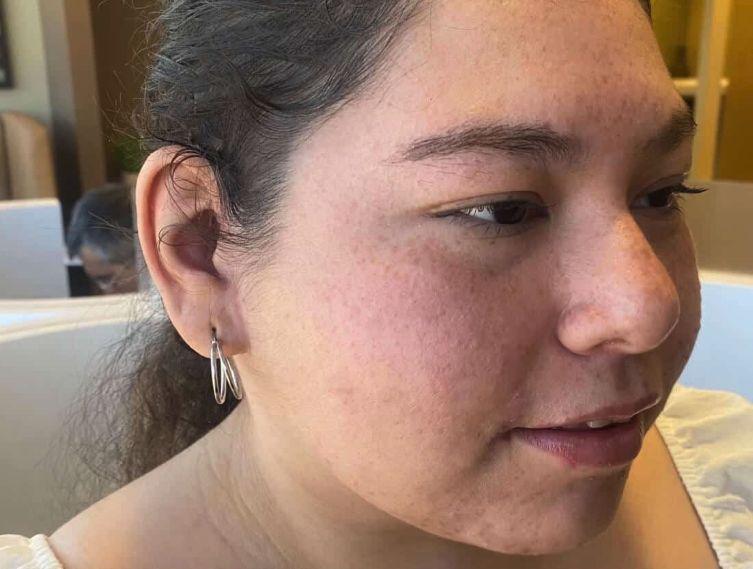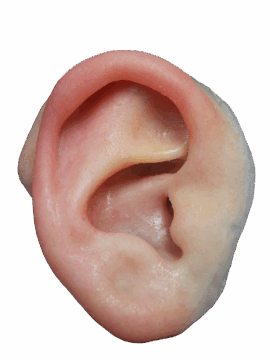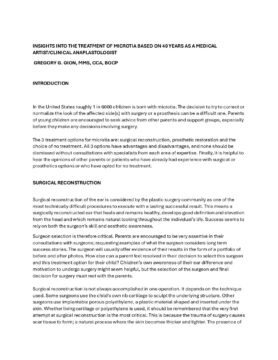Our team has decades of clinical experience in ear prosthetics.
We will create a simple treatment plan to get your new ear prosthesis where and when it works best for you. Your ear will be meticulously restored through the perfect blend of medical art skills and cutting-edge digital scanning and 3D printing. You can opt for the easy slip-over ear prosthesis or a secure adhesive-retained prosthetic ear. We also provide bone-anchored prosthetic solutions that magnetically attach to permanent osseointegrated screws. Our practice has been a leader in osseointegration anaplastology since 1984.
What is Anotia and Microtia?
Anotia and Microtia are birth defects where the ear does not form at all (Anotia) or it begins to grow but it does not develop fully into the normal shape. It is smaller than normal (Microtia). The congenital deformity can be unilateral (one side only) or bilateral (affecting both sides).
Learn about how we can create custom ear prosthetics for you.

Gloria G's Story
Arizona
I went in knowing nothing about the process of getting a prosthetic but Maddie explained every detail, showed me why an how she did her magic. She welcomed and showed genuine care with my concerns. She even made sure I can wear earrings and listen to music again. This prosthetic ear is the best I could have asked for! 10 out of 10
What are the 4 types of Microtia?
- the mildest form; the ear is basically normal in shape but just smaller in size.
- the ear is mostly normal, especially the lobe, but the upper half of the ear is not fully formed.
- the ear is very small and often resembles the shape of a peanut. There is no ear canal, which is called Aural Atresia.
- no ear tissue is present at all. The area is basically flat. This is called Anotia.
What causes Anotia and Microtia?
The exact causes of anotia/microtia in most infants are unknown. There may be genetic factors, a change in their genes, and other environmental factors may attribute to it as well. More information about causes can be found online. One source is the Centers for Disease Control (CDC).
Frequently Asked Questions
Yes, when both ears are small or absent this is called bilateral microtia or bilateral anotia.
If the ear canal and ear bones are affected then the child will not have normal hearing. However, even if there is no ear canal (aural atresia) the child with microtia can still hear some sounds because the nerve used for hearing may still function normally.
Children may notice their ear difference as early as 2 or 3 years of age. When they are in pre-school or kindergarten they may find other children reacting to them differently and become more aware of their difference.
It will be helpful to get ideas and support from your pediatrician and other clinicians. Be open and honest so your child is comfortable that you are ok with his or her ear difference. Open discussion will help your child with feeling that ist is ok. You could kind of casually rehearse what your child might want to say to friends when confronted about the ear difference. For instance your child could say, “so my ear doesn’t look the same but I still play just like you and everybody else.” We know microtia plays into one’s identity, but it is just a small aspect of a wonderful complex person. Treat your child with love and support without undue focus on the microtia. Support of their own unique wonderful self will foster self-esteem for a long full happy life.
- No treatment (leave the microtia alone).
- Surgical reconstruction of the ear (Rib cartilage or artificial plastic like Medpor is used to create the implanted shape).
- Ear prosthesis to cover or replace the microtia.
This becomes a personal choice and often your observation of your child becoming aware of their difference is the time to discuss the options. Much consideration should be given to any decision involving surgery.
One paper discussing the subject is: Surgical Versus Prosthetic Reconstruction of Microtia: The Case for Prosthetic Reconstruction
Challenges of successfully wearing any prosthetic device – including silicone prosthetic ears for children – are relative to the way they are crafted and cared for. Of course, any prosthesis is removable so it requires some care and cleaning. Therefore, the edges of the prosthesis where they blend with the skin may become loose or worn causing them to be more visible. They then may require rebonding with adhesives or refinement of the material. Skin color and the coloration of the prosthesis both change from sun exposure over time so the prosthesis will eventually need retinting or replacement in order to continue to match and blend in.
Many of the challenges of prostheses are so well addressed by dedicated silicone ear prosthesis specialists that prosthesis wear becomes a far superior choice relative to the alternative of accepting the attention of untreated microtia or having complicated surgery attempts to build an ear that never looks normal, let alone one that matches the unaffected side. It is true that any prosthesis no matter how expertly crafted will lose color over time and have margins that may be visible to you. However, planning for retinting or replacement of the prosthesis and realizing that expertly planned margins are rarely detectable by others make the accurate prosthesis the optimal lifetime choice.
Proponents of ear reconstructive surgery will also point out that a disadvantage of the ear prosthesis is that its routine removal and the lack of sensation when touching the prosthesis reminds the patient that its not part of their body. However, like a removable denture or hairpiece all prostheses have functions so valuable they far outweigh going without. So one must weigh the few minutes involved in daily prosthesis attachment and removal against many hours each day feeling uncomfortable hiding a poorly formed or failed surgical reconstruction by wearing a long hair style or just accepting the same looks, stares and questions that arise from living with untreated microtia. An artistically rendered and well maintained ear prosthesis is virtually undetectable. Decades of practice has proven that a relationship develops between prosthetist and patient and the care and passion going into the prosthesis translates to a confidence for the patient of feeling and looking completely balanced, normal and unremarkable throughout their daily life.
As soon as parents have concerns it is advisable to start identifying professionals offering the various treatment options. This way parents can be prepared with options tailored to the specific diagnosis of their child and the availability of professionals who are experts representing the best treatment options. This is important since there are very few talented and focused surgical and prosthetic professionals that truly specialize in the ear. It cannot be overstated how crucial it is to NOT select a surgeon or an ear prosthetist until you have been shown many pictures of patients before and after their respective treatments to demonstrate the experience of the provider and the results they achieve. This is especially true of any surgical intervention because any failed first surgery causes scar tissue to form. This makes it even more difficult if not impossible for a surgeon to go back and repair or improve the look of the reconstructed ear. No one is happy with a surgical reconstruction that does not even look like an ear, or a poorly rendered prosthetic ear that is easily detected. The gold standard is seeing close-up photographic results as evidence of artistry and expertise.
It may be very helpful for the child months before beginning school at age 5 or 6 to have some opportunity to test and wear an ear prosthesis. This way with no surgery no bridges have been burned, and the child can have the opportunity to contribute to the decisions involving his or her ear.
Surgical Versus Prosthetic Reconstruction of Microtia: The Case for Prosthetic Reconstruction
by Gregory G. Gion, BA, BS, MMS, CCA*
The auricular prosthesis and the autogenous reconstruction must ultimately be judged on their ability to free the patient from the stigmatization of their condition. Excellent esthetic results are key in providing patients with the confidence that their correction will go undetected. There are other technical and psychological issues that impact prostheses success in particular, but the wide variability in esthetic quality available historically and around the world today might still be unnecessarily complicating if not biasing the treatment selection process.
THE AESTHETIC EAR PROSTHESIS
This guide is prepared to introduce the option of wearing an aesthetic ear prosthesis within the context of all the options currently available to patients and parents of children with microtia.
We can complete many types of total or partial ear prostheses in 2 or 3 days if you want to come and stay near our office. If we select a more complex attachment system, it might require just an extra day or two. Otherwise, you can arrange to make separate visits. We are very flexible and will create a plan that works for you. (The magnetic types that attach to bone-anchored posts take longer because of osseointegration time which is 2-3 months)
No. A lifelike silicone ear prosthesis is not implanted under your skin or attached to your body permanently. Even if it is a bone-anchored (osseointegrated) prosthesis– it must be taken off regularly to be washed and to maintain the cleanliness and health of your skin.
Ear/auricular prosthesis are attached using adhesives, by magnetic attachment to osseointegrated fixtures, by gently fitting like a puzzle piece into existing ear anatomy, by attachment to the earpiece of glasses, or by our “slipover” method. The prosthesis flexes to slip over your microtia or reconstructed ear tissue.
We go over all the methods that will work best for you, including osseointegration. Your doctor will help determine if osseointegration is appropriate. Your preference counts the most, but we make the decision together.
Osseointegration is when small screws fixated into bone act as permanent anchors for the prosthesis. Surgeons we collaborate with place the fixtures, then we use the magnetic components that attach the prosthesis to the fixture poasts (abutments). We have been refining osseointegration attachment to orbital, nasal, and auricular prostheses since 1984.
In general, we recommend that you remove your prosthesis at night for cleaning and to allow your skin to breathe. Some patients then learn from experience that they can adjust their wearing schedule. We provide personalized wear and care instructions for each client.
Almost all silicone prostheses are washed daily using isopropyl alcohol, detergent soaps like Dawn or Dove, and then rinsed, and kept dry when not in use. However, each prosthesis is unique and might require special precautions. Ultimately, we will walk you through your daily care plan and provide specific instructions tailored to your unique prosthesis.
The cost of a slip over ear prosthesis for microtia, a partial ear, and the implant-retained magnetic ear prosthesis will depend on your specific condition and the wide range of attachment options appropriate for you.
It is possible that your insurance will cover some or all the costs. After we receive your permission and insurance information our insurance specialist will help determine the level of coverage of your insurance plan.
The medical and insurance community often say 2 or 3 years is the average lifespan of a silicone facial prosthesis. Insurance might then pay for a replacement. Many of our patients wear the original prosthesis for several more years with an occasional retinting. Identical replacement prostheses are then available from the original mold taking just a day or two and at substantially less cost to you.
We do not recommend wearing the ear prosthesis during contact sports, or vigorous activities where it could be dislodged and lost. Otherwise, use your prosthesis however you feel comfortable.
These activities will not hurt the prosthesis. However, vigorous movements and/or sweating could affect the bond/security of adhesive-retained prostheses. We recommend wearing your prosthesis at home at first during strenuous type activities to become familiar with the strength of the prosthesis attachment.
We do not recommend sleeping with the prosthesis on – at least not on a regular basis. This is for maximum longevity of your prosthesis’ surface finish and for the health and hygiene of your skin under the prosthesis, especially for implant-retained auricular prostheses.
Infection rates around these abutments may be found in the literature. Two sample references for you:
Long-term outcomes of craniofacial implants for the restoration of facial defects Int. J. Oral Maxillofac. Surg. 2018; 47: 773–782 https://doi.org/10.1016/j.ijom.2018.01.013 https://www.sciencedirect.com
Survival and complications of implants to support craniofacial prosthesis: A systematic review. Journal of Cranio-Maxillofacial Surgery Volume 44, Issue 10, October 2016, Pages 1536-1552 https://www.sciencedirect.com/science/article/abs/pii/S1010518216301664
I hope this information helps in getting comfortable with the decision to have an ear prosthesis, whether it is a slip-on anatomical fit, attached with adhesive, or is the implant-retained type.
When you decide to have a prosthesis, it then becomes important to ask questions about the practitioner who will create and fit your prosthesis. We recommend critiquing the accuracy and aesthetics of a series of case results. When you see samples of accurately detailed and carefully crafted ear prostheses is an indicator that the practitioner has specialty experience in comprehensive ear prosthetics care. Pre-treatment planning, prosthesis design, patient education in proper hygiene, and follow-up care all promote maximum success in ear prosthetics.




